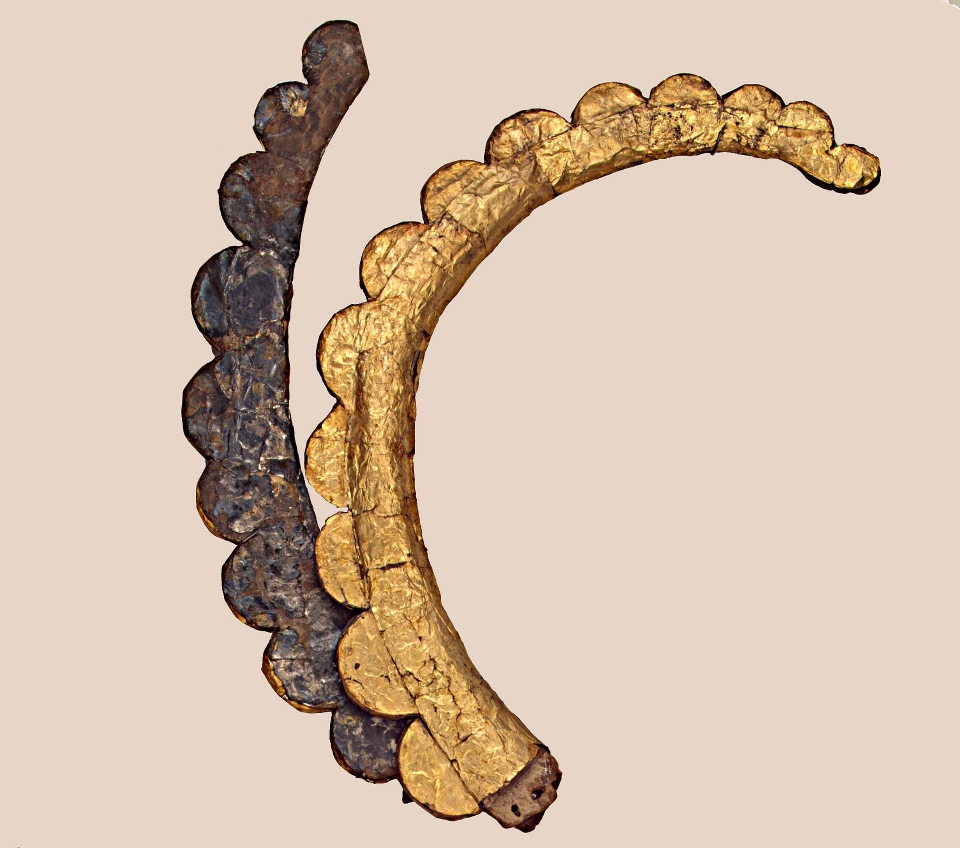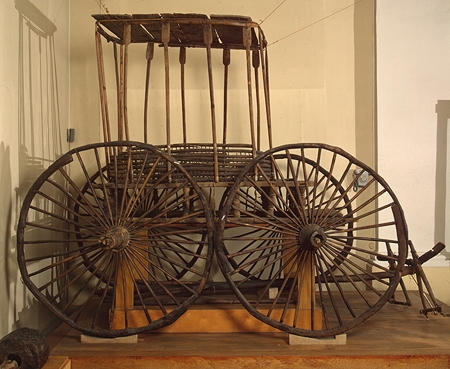復元されたカーペットの鮮やかさと柄が素晴らしいです。
ロシア パジリク文化 紀元前6世紀
発掘場所:中央アルタイ、カラコル川のバシャーダル地区。第2バシャダル古墳
(S.I.ルデンコ1950年による発掘調査)
Pazyryk culture. 6th century BC
Found: Central Altai, Bashadar tract on the Karakol River. Second Bashadar Mound (excavations by S.I. Rudenko 1950)
1924年、S.I.ルデンコが初めてアルタイにやって来ました。彼は40代でした。それまでには、人類学、民族学、考古学における長年にわたる実りある努力がありました。セルゲイ・イワノビッチは、狭い現代感覚の考古学者ではありませんでした。彼は賢明で広く教育を受けた地理学者で、その研究の目的には、現代人と古代人、それらの人々が住んでいた自然の状態で調査することが含まれていました。歴史家の独創性が明らかになったのは、自然地理的条件と密接に関連して、歴史的および民族学的な問題に対する科学者の非常に広範なアプローチでした。
In 1924, S.I. Rudenko first came to Altai. He was in his forties. Behind was many years of fruitful hard work in anthropology, ethnography and archaeology. Sergey Ivanovich was not an archaeologist in the narrow modern sense of the term. He was a brilliantly erudite, widely educated Geographer, whose object of research included both people, modern to him, and ancient, and natural conditions among the people in which these people lived. It was in the extremely broad approach of the scientist to historical and ethnographic issues, in close connection with their natural-geographical conditions, that Rudenko-historian's originality was manifested.
乗馬
紀元前6世紀の第2バシャダル古墳の馬は永久凍土に保存され、その図案を詳細に考えることを可能にする本物の古代のハーネスの美しい例です。彼女の発見の前に、アッシリア人、ペルシャ人、黒海スキタイ人のハーネスは、画像によってのみ知られていました。それは優秀な革のねじれた糸から縫い付けられた2つの厚い革革で構成されます。通常、アルタイの人々は木製の裏地で馬の服を飾りましたが、第二バシャダル古墳では、ブロンズの板、黄金のシートのセットが見つかりました。S字型の詩篇の端とベルト用の28個の飾り板には、獲物の鳥の頭の強く様式化されたイメージを表す、真ん中に「コンマ」を持つ非対称の花びらのモチーフを使用しました。同様に、胸のストラップも装飾されています。
The riding horse from the Second Bashadar Mound of the 6th century BC is a beautiful example of a genuine ancient harness preserved in the permafrost and allowing to consider its device in detail. Before her discovery, the close-to-like harness of assyrians, Persians and Black Sea Scythians was known only by images. It consists of two thick straps, sewn from excellent leather twisted tendon threads. Usually the Altai people decorated horse clothes with wooden linings, but in the Second Bashadar mound a set of plaques cast in bronze and clad with sheet gold. At the ends of the S-shaped psalms and on 28 plaques for the belts used the motif of an asymmetrical petal with a "comma" in the middle, perhaps representing a strongly stylized image of the head of a bird of prey. Similarly, the breast strap is also decorated.

A frenulum in the form of an eagle
ワシの形をした置物
ロシア パジリク文化 紀元前6世紀
発掘場所:中央アルタイ、ウルスル渓谷のトゥエクタ村。トゥエチン古墳(1954年のS.I.ルデンコによる発掘調査)
A frenulum in the form of an eagle
Created: Russia. Pazyryk culture. 6th century BC
Found: Central Altai, Tuekta village in Ursul Valley. The first Tuektin Mound
木製のワシの置物は、ウルスル川渓谷のトゥエクタ村の近くの、アルタイで最大の古墳発掘中に発見されました。第一トゥエチン古墳は直径約68m高さ4mで、石の古墳は大きなブロックの二重フェンスで囲まれています。永久凍土の深さ7メートルの墓で、カラマチの幹で作られた巨大な石棺を持つ二重丸太を完全に保存しました。古墳は古代に略奪されましたが、墓に埋葬された馬の中で、馬のハーネスの6世紀の装飾、多くの木製の置物や浅浮き彫りを発見しました。その中で、ワシのイメージはラコニック解釈によって特徴付けられます。明らかなシルエット、軽さの感覚は、紀元前6世紀のスキタイのメルグノフ古墳から同様の黄金の鳥に近いアルタイワシをもたらし、このモチーフはスキタイ人とアルタイの芸術になくなります。
The wooden eagle figurine was found during excavations of one of the largest mounds on the Altai near the village of Tuekta in the Ursul River valley. The height of the First Tuektin mound is 4 m, about 68 m in diameter, the mound of stones is surrounded by a double fence of large blocks. In a grave 7 m deep in the permafrost perfectly preserved double log with a huge sarcophagus, made of larch trunk. The mound was looted in antiquity, but among the horses buried in the grave found many linings, wooden figurines and bas-reliefs, which served in the 6th century BC decorations of horse harness. Among them, the image of the eagle is characterized by restraint and laconic interpretation. A clear silhouette, a sense of lightness of a soaring flight bring the Altai eagle closer to a similar golden bird from the Scythian Melgunov Mound of the 7th century BC After the 6th century BC, this motif disappears in the art of the Scythians and the Altai.

三日月型の鞍の前橋(ぜんきょう)のペア。馬の頭飾りの装飾
ロシア パジリク文化 紀元前6世紀
発掘場所:中央アルタイ、カラコル川のバシャーダル地区。第2バシャダル古墳(S.I.ルデンコ1950による発掘調査)
A pair of horns - the decoration of the horse's headdress
Created: Russia. Pazyryk culture. 6th century BC
Found: Central Altai, Bashadar tract on the Karakol River. Second Bashadar Mound (excavations by S.I. Rudenko 1950)
巨大な木製の前橋は、紀元前6世紀に埋葬された、ボロボロの頭飾りや馬のマスクと一緒に発見されました。前橋は、いくつかの部分から接着されています。各前橋の平らな側面は銀の板で覆われており、凸面は金の葉が貼り付けられており、その腐った端は、明らかにヤギの角のカーブを模倣しています。このような装飾はまれであり、明らかに、いくつかの特別な儀式、おそらく、祈祷の儀式のために作られました。この角のカーブのあるマスクが数点、最初と5番目のパジリク古墳で発見されました。このような非常に異なるタイプの被り物が、アッシリアの画像に見られます。黒海のスキタイ人の馬は、「動物」スタイルでエレガントな頭飾りと頬パッドで飾られました。
Huge wooden horns were found along with a worn-out headdress or a horse mask buried in the 6th century BC, the horns were glued together from several pieces. The flat sides of each horn are covered with plates of sheet silver, and the convex are pasted with gold leaves, the festering edges of which, apparently, imitate the annual rings of goat horns. Such decorations are rare, obviously, they were made for some special ceremonial, perhaps, cult ceremony. Several masks with figurines and horns crowning them were found in the First and Fifth Pazyryk mounds. Lush headgear, but of a very different type, are found in Assyrian images. The horses of the Black Sea Scythians were decorated with elegant headbuts and cheek-pads in the "animal" style.

エルクの3つの頭の形バスレフ。馬のハーネスの装飾
ロシア パジリク文化。紀元前6世紀
発掘場所:中央アルタイ、ウルスル渓谷のトゥエクタ村。最初のトゥエチン古墳(1954年のS.I.ルデンコによる発掘調査)
Basleph in the form of three heads of elk - decoration of a horse harness
Created: Russia. Pazyryk culture. 6th century BC
Found: Central Altai, Tuekta village in Ursul Valley. The first Tuektin Mound (excavations by S.I. Rudenko in 1954)
トゥエクタ村の近くの大きく略奪された古墳で発見されたこの彫刻された木製の品は、馬のハーネスの装飾として使われました。それぞれが異なるエルクの3つの頭の組成を表します。すべての頭は、時計回りに移動するかのように、右向きです。これはスワスタ型の組成のバージョンで、4本ではなく3つの光線からなる。パターンの中心では接続され、凹面の側面を持つ図が形成されます。古代の太陽のシンボル。サキとスキタイ人の作品では、スワスティカ型の構図は、永遠の動きとあらゆるものの円形の象徴として機能します。

カーペット
印象的なのは30平方メートルのカーペットで、他の3つの同様のカーペットと一緒に埋葬テントの壁に掛けられました。白いフェルト部分にはアップリケが施されて色のパターンを作り、神聖な木を手に持つ騎手が椅子に座る女神に近づく、2つのストライプ模様が繰り返されます。
テントからは土台となる丸太を保存し、切れ目を入れてバーを支える柱を挿入し、頂上にテントを飾る白鳥の丸太を飾りました。
Impressive is the 30-square-metre carpet, which, along with three other similar carpets, hung the walls of the burial tent. On the white felt field in the technique of appliques are performed color patterns and repeated on two stripes images sitting in a chair of the goddess with a sacred tree in his hand and the rider approaching her. From the tent also preserved logs, which served as its base, with slits, which inserted poles that supported the iail cover, and the logs of the swans, which decorated the tent on top.
驚くべき発見は、イランや中央アジアの作品の羊毛カーペットでした。紀元前5世紀と4世紀に製造され、その発見は1700年前に最も初期に知られているパイルカーペットの生産時期を変えるのに役立ちました。パジリク古墳のカーペットは、高度に発達した非常に完璧な技術を示しています。多数の色の撚り合せた糸は、結び目に基づいて接続され(すべての平方センチメートルは、36のそのような結び目を占める)、前面にトリミングされ、固体と非常に緻密なビロードの表面を形成します。カーペットは、鹿、騎手、翼を持つグリフィン、パターンでエレガントに装飾されています。経験豊富な現代の職人は、このようなカーペットの製造には、少なくとも1年半を費やす必要があると推定しています。
A remarkable find was a woolly sheared carpet of Iranian or Central Asian work. It was manufactured in the 5th and 4th centuries BC, and its discovery helped to shift the time of production of the earliest known pile carpets 1700 years earlier. The carpet from the Pazyryk mound shows a highly developed and very perfect technique of execution. Numerous colored strands, connected on the basis of knots (for every square centimeter accounts for thirty-six such knots) and trimmed on the front side, form a solid and very dense velvety surface. The carpet is elegantly decorated with ornaments with images of deer, horsemen, winged griffins, as well as patterns. It is estimated that an experienced modern craftsman would have to spend at least a year and a half on the manufacture of such a carpet.



パジリク古墳出土のウールカーペット。紀元前5世紀から4世紀 エルミタージュ蔵
Wool carpet from the mound of Pazyryk. 5th - 4th century BC State Hermitage
第五パジリク古墳に完全に保存され、解体された形で埋葬されていた大きな木製の戦車(最大3メートルの高さ)が出土し、考古学者によって復元されました。枝の一部で輸送することを可能にした戦車の設計は、これらの部分を接続し、ベルトでそれらを留め、再びワゴンを受け取るために、遊牧民のニーズに最も適していました。4頭の馬が戦車につけられました。扱いにくく不器用で(前軸はまだ強化されている)、草原の横断にのみ適していました。
In the Fifth Pazyryk mound found fully preserved and then restored by archaeologists in its original form a large wooden chariot (up to three meters high), which was in the burial in disassembled form. The design of the chariot, which allowed to transport it in parts on the branches on mountain paths, and on the plain, connecting these parts and fastening them with belts, again to receive the wagon, was most suitable for the needs of nomads. Four horses were put in the chariot. Unwieldy and clumsy (the front axis is fortified still), it was suitable for crossings only on the steppe plains.

第5パジリク古墳出土のチャリオット。紀元前5世紀から4世紀 エルミタージュ蔵
Chariot from the Fifth Pazyryk Mound. 5th - 4th century BC State Hermitage